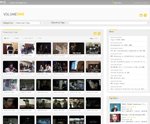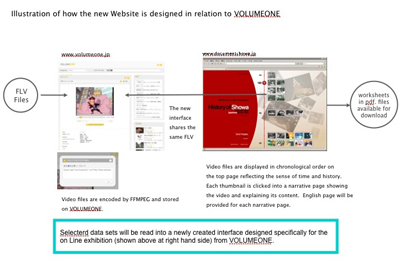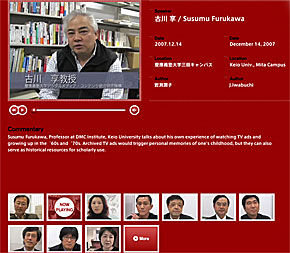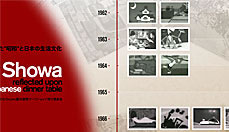Introduction
The on-line exhibition titled History of “Showa” reflected upon [the] Japanese Dinner Table was released to the public on Jan. 25, 2008 in hopes of showcasing selections of archived video files as an exhibition on the Web.

Fig1: Index page of the on-line exhibition History of “Showa” reflected upon Japanese Dinner Table http://www.documentshowa.jp
Prior to the preparation of the on-line exhibition History of “Showa” reflected upon [the] Japanese Dinner Table, The Research Institute for Digital Media and Content (DMC Institute), Keio University, Tokyo, Japan, exchanged a Memorandum of Understanding with Kawasaki City Museum (KCM) to launch a collaborative research project as of August 1, 2006. The DMC Institute had been working on digitization of the KCM collection of TV advertisements by Momoya Co., Ltd. The collection consists of 218 TV ads in total, that date back to 1953; 124 pieces among these so-called “Norihei Anime” series began in 1958. The 50 pieces shown here on this on-line exhibition include the one produced in 1958 and continue up to those released in 1993.
Digitization and metadata extraction of the pieces in the collection had been completed by the end of June, 2007, and these valuable materials have been partly available on-line (choose Project 1 in the Categories) for public viewing at the video files distribution platform VOLUMEONE, operated by DMC Institute, Keio Univ., since the beginning of October, 2007. Amongst 218 video clips, 124 “Norihei Anime” animated pieces were modeled after a real life comedian Mr. Norihei Miki. Courtesy of Momoya Co., Ltd. and our research partner Kawasaki City Museum, the DMC Institute has been given the privilege of showing these materials on-line for the purpose of research and education.

Fig 2: Top page view of the VOLUMEONE http://www.volumeone.jp
About the on-line Exhibition
For this on-line exhibition, 50 pieces were selected from among these 124 animated TV advertisements, in order to demonstrate the popular culture of postwar Japan on the theme of quotidian living of the Showa era. The “Showa” era literally means the period of "enlightened peace," or the period of Japanese history corresponding to the reign of Emperor Hirohito, from December 25, 1926 to January 7, 1989. This on-line exhibition is a reflection of the transfiguration of Japanese society from the postwar years to the year 1993. It was commissioned by the Agency for Cultural Affairs of Japan, to promote international exchange in Arts and culture through collaborative efforts with partners abroad.
The intention of this project is cross-cultural understanding through the expression of quotidian living depicted in TV ads. In this regard, the organizers made an effort to show how Mr. Norihei Miki, who is absolutely versatile with many talents and a man of knowledge, together with the members of his creative team, had conceived ideas for those TV ads. Through this exhibit, audiences overseas can comprehend them with ease. Also, another aspect of this project is adaptation of the sophisticated technique of Japanese animation that has frequently appeared, even in TV advertisements.

Fig 3: Illustration of how the narrative page for each video is laid out
To fulfill the purpose of this on-line exhibition, the latest technologies such as Action Script 3 and Papervision 3D have been implemented while developing the new Web inspired by the sense of time and history. We developed an interface that responds to that idea, adopting the chronological scale into the navigation system of the whole content.

Fig 4: Illustration of how the new interface is designed in relation to VOLUMEONE
Designing the Workshop for a Non-Japanese Speaking Audience
Concerning the workshop, we have worked out the plans through dialogues with Tokyo Wonder Site (TWS) of the Tokyo Metropolitan Foundation for History and Culture, that takes a leadership in promoting the Artists-in-Residence program on behalf of the Tokyo Metropolitan Government. The DMC Institute exchanged a MOU also with TWS to launch a collaborative research project as of June 1, 2007. Concurrently, based on the content and the worksheets of this Web site, a series of workshops will be held on the theme of Japanese art, food, culture, animation, and so on, and its target participants include children of various ethnic backgrounds.
It is a great pleasure for the project committee that through this on-line exhibition and the distribution of worksheets in 4 different languages, the workshop about Japan will be held everywhere in the world and provide opportunities to promote interest in the history or culture of Japan for people all over the world.
About the Momoya TV Ads Collection at the Kawasaki City Museum
The Kawasaki City Museum collection of Momoya TV ads was donated in block, for the benefit of research and education, by the Japanese leading processed food company, Momoya Co., Ltd., in 1993 to commemorate 35 consecutive years of broadcasting “Norihei Anime”. In fact, Momoya Co., Ltd. also donated the same collection of Momoya TV ads to the Broadcast Library of the Broadcast Programming Center of Japan in Yokohama, Kanagawa prefecture. It is possible to watch the collection of Momoya TV ads on site. The data that Kawasaki City Museum employed for digitization for on-line use is the collection of KCM.
Social and Historical Significance of the Collection
TV ads launched by Momoya Co., Ltd., well known for its product EDO-MURASAKI, can be considered as the mirror that reflects the history of the Showa era and the cultural transition of the Japanese people’s daily living, as social phenomena, fashions and manners of each times are portrayed. By the on-line exhibition of these TV ads, many people, for example, modern or contemporary historians, artists, art critics, advertising industry employees, businessmen, and lawyers specializing in copyright, could have access to them, and the organizers hope to discuss and explore how these archived TV ads can be utilized or applied as methodology for scholarly research and historical investigation.
Continuing discussions and persistent demand will encourage corporations to disclose their advertising resources of the past and make them available on-line for the benefit of society at large. If. museums explore the better use of those video clips for education and research, and if society recognizes the impact of their benefit, the number of accessible materials released from corporations may be increased dramatically. These materials will be ideal for overseas researchers who specialize in Japanese Studies.

Fig 5: Commentaries on the project can be also watched on-line
As well, how much could the younger Japanese generation understand these materials today without explanation? It is probable that even Japanese audiences will need detailed commentary on the history of Japanese culture and Arts for each piece, similar to that provided for overseas audiences. On the other hand, there will be also many audiences who feel nostalgic for the times when these TV ads were on air. In this respect, as materials utilized in classroom situation, TV ads will have a social function if students retrace the Showa era that their parents and grandparents lived, and think about the social transition of eating, working and raising families of the era. Also, for overseas universities or institutes, TV advertisements will serve as important historical materials and complements to official documents when conducting research on the history of postwar Japan. Moreover, they may provide a chance to have non-Japanese children exposed to the culture of Japanese food.
Our Hope and Future Goal
In reality, video contents such as TV ads are bound by various rights. Due to such difficulties, there are many cases where TV ads are not frequently exhibited on-line, even if the company that commissioned the advertisements is cooperative.
Therefore, it is necessary to reconsider the value of TV advertisements as historical material, and to raise awareness among the public about how video content, as material for education and research, should be regarded as being in the public domain. The project committee truly hopes that discussions about the social significance of the wide on-line release of TV ads, and public rulemaking for the educational and scholarly use of TV ads, where rules should differ from the ones for commercial use, will be examined.
Acknowledgments
For making this on-line exhibition and workshop programs possible, the organizers would like to thank Maki Yamamura, Mai Kato, Megumi Komazaki, Hiromi Kosaka, Noemi Hiraishi, Kentaro Hirano, Masaru Ando and Kenichi Suzuki for contributing their talents and valuable time. Appreciation is extended to Norio Yamamura, Masanori Yamamura, Masako Nomura, Akemi Nemoto, Shoji Satomura and others for providing rare photographs from the Showa era. Thanks are also due to our research partners; Kenjiro Shiga and Koji Hamasaki at Kawasaki City Museum, Yusaku Imamura at Tokyo Wonder Site, Vincent Puig, Johann Holland at The Institute for Research and Innovation (IRI) of the Centre Pompidou, who are also members of this project committee.
The on-line exhibition History of “Showa” reflected upon Japanese Dinner Table is a commissioned work by the Agency for Cultural Affairs of Japan.
References
Iwabuchi, Junko (2006). Taking a Museum Experience to Your Real World - Exploring a New Usage of Museum audio/visual Guides in Children's Hospital, Retirement Homes and More. Last updated Friday, 25-Sep-2006. Consulted January 28,2008. http://museum.dmc.keio.ac.jp/en/CIDOC2006/
Iwabuchi, Junko (2007). “Taking a Museum Experience to
Your Real World with VOLUMEONE:
Introducing a Museum and User Friendly Video Distribution Platform on the Web”.
In J. Trant and D. Bearman (eds). Museums
and the Web 2007: Proceedings. Toronto: Archives & Museum
Informatics, published March 31, 2007 at
http://www.archimuse.com/mw2007/papers/iwabuchi/iwabuchi.html
Iwabuchi, Junko (2007). Accessibility over Security? Or
Security over Accessibility?
-Experimenting with VOD-casting in Museums and Classroom Situation-. Last
updated Friday, 17-August-2007. Consulted January 28, 2008 http://museum.dmc.keio.ac.jp/en/CIDOC2007/
Kaifu, Michi (2008). MOMOYA TVCM archive - "public domain" video effort in Japan, newsvine.com, published Jan.24, 2008 at http://michi.newsvine.com/_news/2008/01/24/1253193-momoya-tvcm-archive-public-domain- video-effort-in-japan.
Kawasaki City Museum is a municipal museum in the vicinity of Keio University and it is known to have a largest collection of films and video next to the National Film Center in Tokyo; it holds the largest collection of Manga comics in Japan. The Research Institute for Digital Media and Content, Keio University, has a project Web site in conjunction with Kawasaki City Museum.
Tokyo Wonder Site (TWS) was established in 2001 and functioning as a gateway for young Japanese artists in coalition with the Tokyo government-hosted "Tokyo Wonder Wall" exhibition. It now has three locations and operates both exhibition programs and artists’ studio (in residence) programs subsidized by Tokyo Metropolitan Government.
Research Institute for Digital Media and Content, Keio University, Tokyo, Japan http://www.dmc.keio.ac.jp/en/ was established as a part of "Encouraging Development of Strategic Research Centers Program" of the Ministry of Education, Culture, Sports, Science and Technology, Japan.
